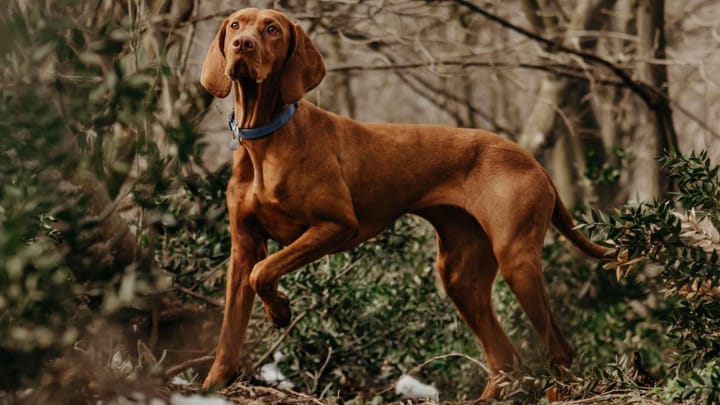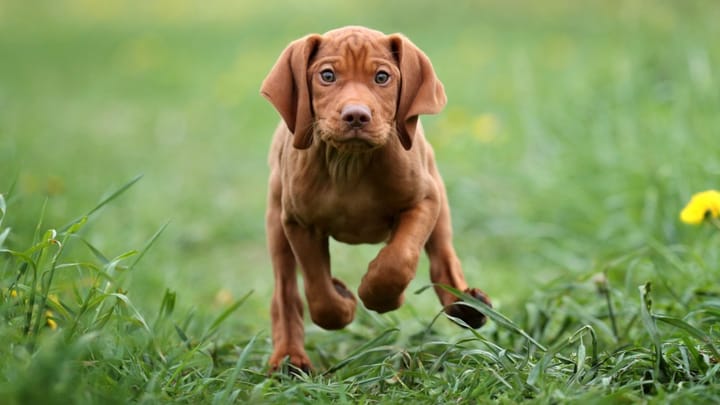Hungarian vizsla
Other names : Vizsla, Wirehaired Vizsla, Hungarian Pointer, Magyar Vizsla, Rövidszörü Magyar Vizsla, Drötzörü Magyar Vizsla


The Hungarian Pointer exists in two varieties: the short-coated and the wire-haired Vizsla. The two breeds are distinct but possess the same working skills. They are versatile hunting dogs, employed in plains, woods and water. The Vizsla, as it is more commonly known, has an incredible sense of smell, is a great retriever and has a fair amount of social competence. In this, he is a premium choice for an assistant to any hunter. He is also an excellent companion dog that brings joy to both small and big ones alike, and that can adapt to many different lifestyles.
|
Life expectancy |
The Hungarian vizsla has a life expectancy of between 12 and 13 years |
|
Temperament |
|
|
Size |
Medium
|
|
Adult size |
Female
Between 21 and 24 in
Male
Between 23 and 25 in
|
|
Adult weight |
Female
Between 40 and 77 lb
Male
Between 44 and 60 lb
|
|
Coat colour
Generally fawn or sand-coloured, the coat can be any shade of russet gold. |
Sand |
|
Type of coat
The coat is short. The short-haired variety has a close-lying coat, coarse and hard to the touch, and lacks an undercoat. The wire-haired variety has a coat that is commonly described as ‘wiry’, spread flat, dense and matte, with an abundant and water-repellent undercoat. |
Short Hard |
|
Eye colour
The eyes usually match the coat but should be as dark as possible. |
Brown
|
|
Purchase price |
The Hungarian vizsla costs between £780 and £1010 |
The wire-haired Vizsla is indeed a breed in its own right, created in 1930, but does nevertheless possess the same capacities and temperament as the short-haired Vizsla.
More details about the Hungarian vizsla
Hungarian vizsla: Origins and history
We know very little about his origins: he is perhaps the result of a cross between a Hungarian Hound (a short-legged Transylvanian or Pannonian Hound) and a ‘yellow’ hunting dog from Turkey. Recent studies have brought attention to the presence of Sloughi (Arabian Greyhound) blood in him too. The breed, more commonly called Vizsla, is believed to have been born in the 17th century, but has attained its current characteristics over the course of the 19th century, through cross-breeding with various foreign Pointer breeds.
Physical characteristics of the Hungarian vizsla
The Hungarian Pointer is a very handsome, medium-sized dog, with a noble appearance and light bone structure, lean muscles and very resistant tendons. He has the physique of a genuine athlete, made to run. The head is narrow and the muzzle blunt, not pointy. The stop is moderate. The eyes are rather oval, and exude an intelligent expression. The ears are set slightly to the back and fold flat over the cheeks. The lips are thin and adherent. The limbs are straight and upright: the hind legs form quite an open angle. The tail is carried horizontally in short-haired varieties while it is carried quite low and curled over in the wire-haired variety. In addition to this, the wire-haired variety has a slightly more significant body mass.
FCI classification of the Hungarian vizsla
-
Group 7 - Pointing Dogs
-
Section 1 : Continental Pointing Dogs
Hungarian vizsla: Varieties
- Short-haired Vizsla
- Wire-haired Vizsla
Hungarian vizsla: Characteristics
Hungarian vizsla: Behaviour
Training a Hungarian vizsla
The Vizsla is reputed as being particularly submissive and easy to train, and this is far from being hearsay. This work dog does indeed love to learn, and to please their master.
Therein, he is a very pleasant and cooperative companion, especially if his owner’s approach is coherent, good-willed and fair.
Brutality does not work with this sensitive dog, who digs his heels in at the faintest demonstration of violence, be it physical or psychological.
Hungarian vizsla: Lifestyle
Breed compatibility Hungarian vizsla
Hungarian vizsla: Purchase price
The price of a Hungarian Pointer varies depending on its origins, age, and variety (short-haired or wire-haired). You have to count an average of £1010 for dogs subscribed to the Kennel Club.
With regards to the monthly budget required to meet the needs of a dog of this size, you have to estimate an average of £40 per month.
Hungarian vizsla: Shedding
Average
Lacking an undercoat, hair loss is less significant in short-haired individuals than it is in the wire-haired variety. But at any rate, hair loss is most pronounced during autumn and spring- moulting seasons. During these periods, brushes will have to be carried out daily.
Hungarian vizsla: Grooming
This hunting dog doesn’t require much maintenance, bearing in mind that the wire-haired variety requires more brushes than the short-haired one, that is, in order to maintain the aesthetic and protective qualities of his coat.
Other than that, the folded ears must be checked and cleaned regularly.
Hungarian vizsla: Health
The average life expectancy is 12 years.
Even if he braves all kinds of challenging weather, the Hungarian Pointer is only moderately robust, unlike his fellow Pointers, which are generally more resilient.
The absence of an undercoat in the short-haired Vizsla helps him tolerate heat. Since he loves the water, walks around water sources are recommended.
When he’s working, this dog can tolerate challenging weather without a problem. And even though he prefers to be part of a social group, he can also reside outside, as he is not particularly vulnerable to the cold.
It is only those dogs that do not get a sufficient amount of exercise that could indeed be prone to excess weight, but the latter remains a very rare case with this breed, in light of how energetic it is.
- Hip dysplasia
- Eye defects






